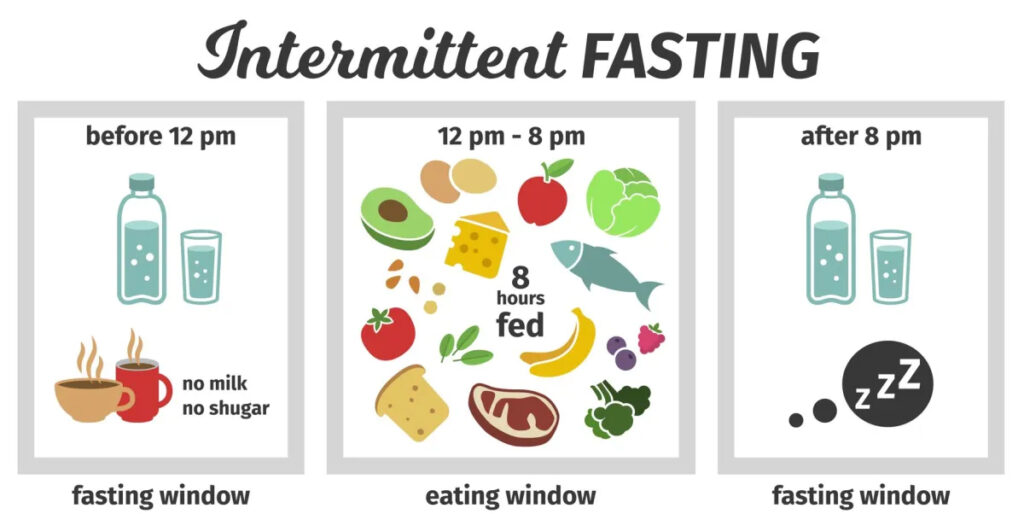
Intermittent Fasting — A Lifestyle, not a Diet
Intermittent fasting, or IF, is more than a health trend — it’s a lifestyle that aligns your eating pattern with your body’s natural rhythm. Instead of focusing on what you eat, IF emphasizes when you eat. It involves alternating between periods of eating and fasting, giving your body the time it needs to reset, repair, and rejuvenate. This simple shift in timing can lead to powerful benefits such as fat loss, increased energy, and improved overall health — all without the stress of counting calories or eliminating your favorite foods.
How Intermittent Fasting Works
When you fast, your body experiences a series of beneficial metabolic changes. As insulin levels drop, your body becomes more efficient at burning stored fat for energy. Growth hormone levels rise, helping preserve lean muscle mass, while a process known as autophagy kicks in — this is your body’s natural way of cleaning out damaged cells and promoting cellular repair. These changes not only improve your metabolism but also enhance mental clarity, reduce inflammation, and stabilize your blood sugar. In short, intermittent fasting gives your body a chance to reset and operate more efficiently.

The Most Popular Fasting Methods
There are several ways to practice intermittent fasting, each with its own rhythm and flexibility. The most common and beginner-friendly method is the 16/8 plan, where you fast for sixteen hours and eat during an eight-hour window, typically between noon and 8 p.m. Some prefer a 14/10 routine, which offers a gentler approach for beginners. Another popular option is the 5:2 method, where you eat normally five days a week and limit calories to about 500–600 on two non-consecutive days. More advanced fasters may choose the Eat-Stop-Eat approach, involving a full 24-hour fast once or twice a week, or even the OMAD method (One Meal A Day), where all calories are consumed in a single meal. Each method can be tailored to your lifestyle and comfort level, making intermittent fasting both flexible and sustainable.
Is Intermittent Fasting for Everyone?
While most adults can explore this way of eating, fasting is not recommended for children, pregnant women, individuals with a history of eating disorders, or those with certain medical conditions. Personalized advice from a healthcare professional is essential.
The real charm of intermittent fasting lies in its flexibility—it can adapt to every lifestyle, whether you are an early riser, night owl, busy parent, or athlete
The Benefits You Can Expect
The benefits of intermittent fasting go far beyond weight loss. Many people experience a boost in mental clarity and focus thanks to more stable blood sugar levels. It supports heart health by lowering bad cholesterol and improving insulin sensitivity, while also promoting longevity through autophagy and reduced oxidative stress. Perhaps one of the most underrated benefits is the improved relationship with food — intermittent fasting teaches you to recognize true hunger and avoid mindless snacking. As your body adjusts, you’ll likely find you have more energy throughout the day and sleep more soundly at night.

Common Mistakes and How to Avoid Them
Like any lifestyle change, intermittent fasting comes with a learning curve. One of the most common mistakes beginners make is overeating when the fasting window ends. It’s important to break your fast gently with light, balanced meals instead of heavy or processed foods. Another mistake is neglecting hydration — water, black coffee, and herbal teas are your best friends during fasting periods. Starting too aggressively can also backfire; it’s better to begin with shorter fasting windows, such as 12/12, and gradually work your way up. Lastly, don’t overlook the importance of good sleep and stress management, as both can affect your fasting results.
What to Eat for Best Results
While intermittent fasting doesn’t dictate what you eat, the quality of your food still matters. Focus on whole, nutrient-rich meals that include lean proteins like chicken, fish, tofu, and eggs; healthy fats such as avocado, olive oil, and nuts; and fiber-packed vegetables and whole grains. These foods keep you fuller for longer and provide steady energy throughout your eating window. Try to limit sugary drinks, refined carbs, and highly processed snacks that can spike blood sugar and make fasting more difficult.
Getting Started with Intermittent Fasting
If you’re new to fasting, the key is to start slow and be patient with your body. Begin with a 12-hour fast and extend the window gradually as your body adapts. Stay hydrated, stay active, and keep yourself busy during fasting hours — the hunger waves usually pass quickly. Remember, consistency is more important than perfection. Intermittent fasting is not a quick fix but a sustainable approach to long-term health and well-being.
Breaking the Myths
Despite its growing popularity, intermittent fasting is often misunderstood. Many people believe fasting slows down metabolism, but short-term fasting can actually boost it. Others fear they’ll lose muscle, yet fasting increases growth hormone levels that help preserve lean mass. Some assume fasting is unhealthy, when in fact, research shows it supports brain health, heart health, and longevity. The truth is, when done correctly, intermittent fasting is one of the most natural and effective ways to improve your overall health.
The Final Word
Intermittent fasting isn’t about deprivation — it’s about balance. By simply changing when you eat, you allow your body to function the way it was designed to. Whether your goal is to lose weight, increase energy, or simply feel better in your own skin, intermittent fasting can be a sustainable and empowering lifestyle choice. Start small, stay consistent, and let your body show you the incredible results that patience and rhythm can bring.
